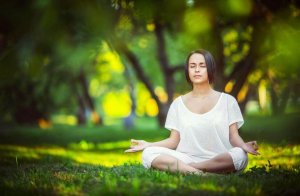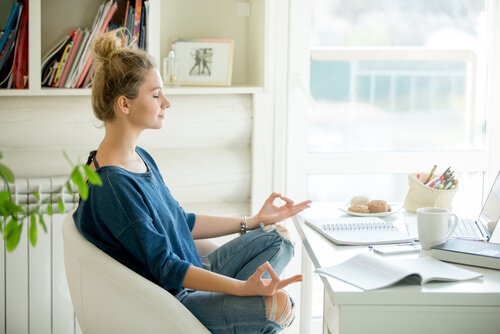6 Simple Meditation Exercises

Stress, like energy, builds up. The paradox is that by increasing the levels of the former, you decrease the levels of the latter. Additionally, both stress and energy can feed off of various sources. Stress, for example, can build up from many different problems. For this reason, we decided to show you some simple meditation exercises that can help release some tension.
In this sense, meditation facilitates self-knowledge. It’s a technique that’s a thousand years old and very common in Buddhism and Hinduism. In recent years, it’s become very popular in the West.
Among the many benefits of meditation, we can find a considerably improved concentration capacity. This can lead to other benefits such as an improved memory. Also, it gives way to physical and mental relaxation. Meditation can even strengthen our immune system.
Without further ado, here are some simple meditation exercises that you can practice to reap all its benefits.
1. Focus on your breathing
The first of these simple meditation exercises is also one of the easiest to incorporate into your routine. It’ll be easier to do if we can sit in a relaxed position with our eyes half-open.
At the same time, we should focus all our attention on our breathing, without trying to change anything. We should just try to feel the air we breathe. When we do this, different distracting thoughts may pop into our minds. Our mission will be to ignore them until they lose their power.

2. Countdown
This technique is simple and very useful for meditating. With our eyes closed, proceed to count down from big numbers such as 50 or 100 until you get to 0. The goal of this exercise is to focus our attention on a single activity so we won’t be distracted by any other sensation or stimuli.
3. Examine your own body: One of the simple meditation exercises
This is one of the most interesting simple meditation exercises. It consists of focusing on the different parts of our body. To do this, it’s advisable to place ourselves in a quiet place. Next, we must focus our attention on each part of our body from head to toe.
We can tense and relax the different muscle groups just to be aware of their presence and their movements. This is a good way to perceive all of our body’s sensations in detail.
4. Active observation
This exercise is based on observing our surroundings. To begin, we must sit down with our eyes closed. Next, we have to open our eyes for a moment and close them again. Then, we have to reflect on what we’ve just seen.
Consequently, we can think about the different sensations the stimuli that reached us produced. We can list them and think about the shapes, colors, and names of each and every object. Additionally, if we do this exercise at home, it can be a good way to see our home with a different perspective.

5. Movement meditation
This simple meditation exercise is based on enjoying the pleasant sensations our body produces when it moves. We recommend doing it while being in contact with nature.
To do so, we can take long walks on the beach or in a forest. Enjoy the sun on your face, the wind, the plants, or the water. This exercise can be another form of self-observation since we can think about our body’s movements while we walk.
6. Fire meditation
Lastly, we can use fire as a symbolic element of purification to focus our meditation on. To do so, we can focus on a bonfire in the field or something easier, like the flickering of a candle’s flame. This lets us perceive the sensations of the fire’s warmth and the shadows it projects.
On the other hand, we can make a list of all the negative things in our life and throw it into the fire. We can either do it in a symbolic or literal way. Either way, this will help us free ourselves from those fears that block us.
Stress, like energy, builds up. The paradox is that by increasing the levels of the former, you decrease the levels of the latter. Additionally, both stress and energy can feed off of various sources. Stress, for example, can build up from many different problems. For this reason, we decided to show you some simple meditation exercises that can help release some tension.
In this sense, meditation facilitates self-knowledge. It’s a technique that’s a thousand years old and very common in Buddhism and Hinduism. In recent years, it’s become very popular in the West.
Among the many benefits of meditation, we can find a considerably improved concentration capacity. This can lead to other benefits such as an improved memory. Also, it gives way to physical and mental relaxation. Meditation can even strengthen our immune system.
Without further ado, here are some simple meditation exercises that you can practice to reap all its benefits.
1. Focus on your breathing
The first of these simple meditation exercises is also one of the easiest to incorporate into your routine. It’ll be easier to do if we can sit in a relaxed position with our eyes half-open.
At the same time, we should focus all our attention on our breathing, without trying to change anything. We should just try to feel the air we breathe. When we do this, different distracting thoughts may pop into our minds. Our mission will be to ignore them until they lose their power.

2. Countdown
This technique is simple and very useful for meditating. With our eyes closed, proceed to count down from big numbers such as 50 or 100 until you get to 0. The goal of this exercise is to focus our attention on a single activity so we won’t be distracted by any other sensation or stimuli.
3. Examine your own body: One of the simple meditation exercises
This is one of the most interesting simple meditation exercises. It consists of focusing on the different parts of our body. To do this, it’s advisable to place ourselves in a quiet place. Next, we must focus our attention on each part of our body from head to toe.
We can tense and relax the different muscle groups just to be aware of their presence and their movements. This is a good way to perceive all of our body’s sensations in detail.
4. Active observation
This exercise is based on observing our surroundings. To begin, we must sit down with our eyes closed. Next, we have to open our eyes for a moment and close them again. Then, we have to reflect on what we’ve just seen.
Consequently, we can think about the different sensations the stimuli that reached us produced. We can list them and think about the shapes, colors, and names of each and every object. Additionally, if we do this exercise at home, it can be a good way to see our home with a different perspective.

5. Movement meditation
This simple meditation exercise is based on enjoying the pleasant sensations our body produces when it moves. We recommend doing it while being in contact with nature.
To do so, we can take long walks on the beach or in a forest. Enjoy the sun on your face, the wind, the plants, or the water. This exercise can be another form of self-observation since we can think about our body’s movements while we walk.
6. Fire meditation
Lastly, we can use fire as a symbolic element of purification to focus our meditation on. To do so, we can focus on a bonfire in the field or something easier, like the flickering of a candle’s flame. This lets us perceive the sensations of the fire’s warmth and the shadows it projects.
On the other hand, we can make a list of all the negative things in our life and throw it into the fire. We can either do it in a symbolic or literal way. Either way, this will help us free ourselves from those fears that block us.
All cited sources were thoroughly reviewed by our team to ensure their quality, reliability, currency, and validity. The bibliography of this article was considered reliable and of academic or scientific accuracy.
- Campagne, D. M. (2004). Teoría y fisiología de la meditación. CUADERNOS DE MEDICINA PSICOSOMATICA Y PSIQUIATRIA DE ENLACE.
- Capdet, P. P. A. (1998). La utilidad de la meditación como modalidad terapéutica. Parte II. Revista Cubana de Medicina General Integral.
- Gálvez Galve, J. J. (2014). Meditación y emociones. Medicina Naturista.
This text is provided for informational purposes only and does not replace consultation with a professional. If in doubt, consult your specialist.







